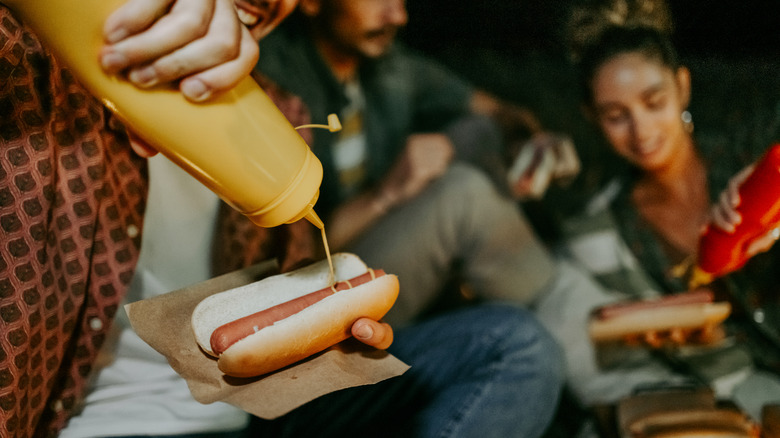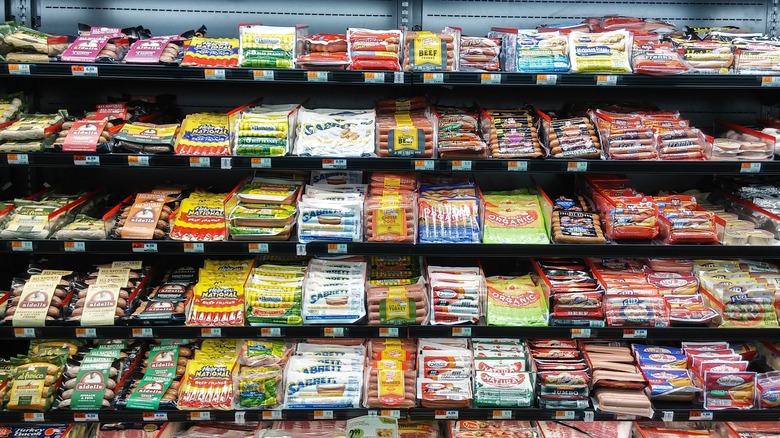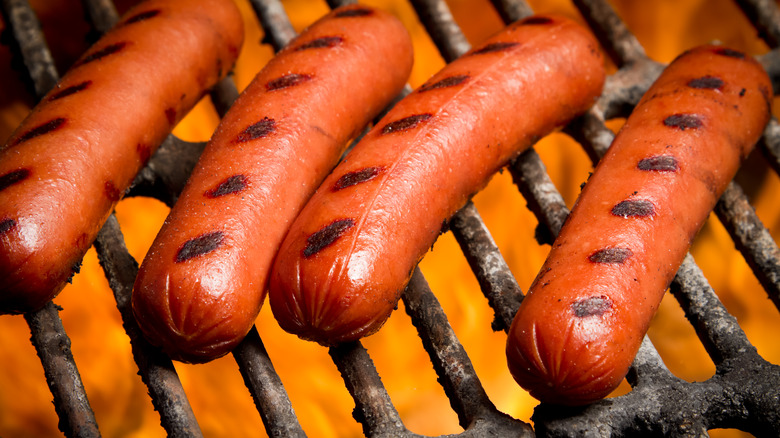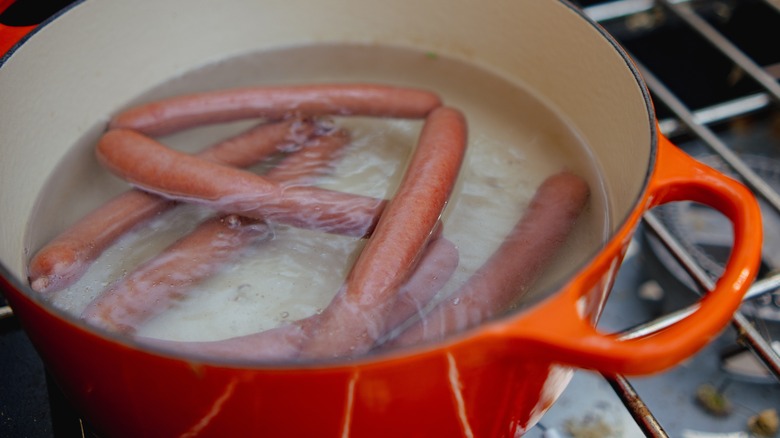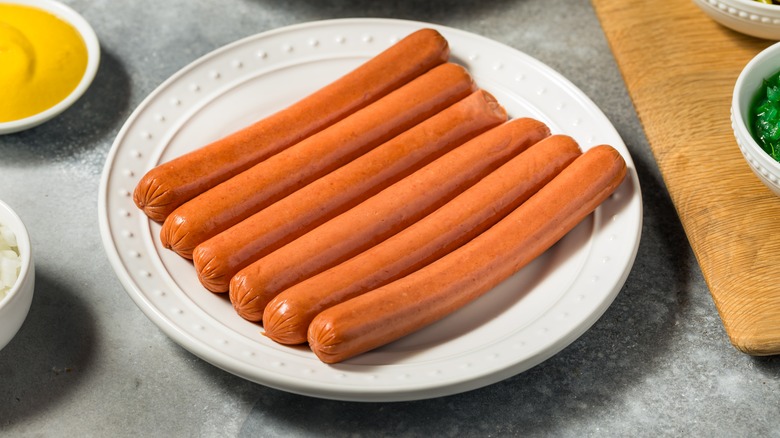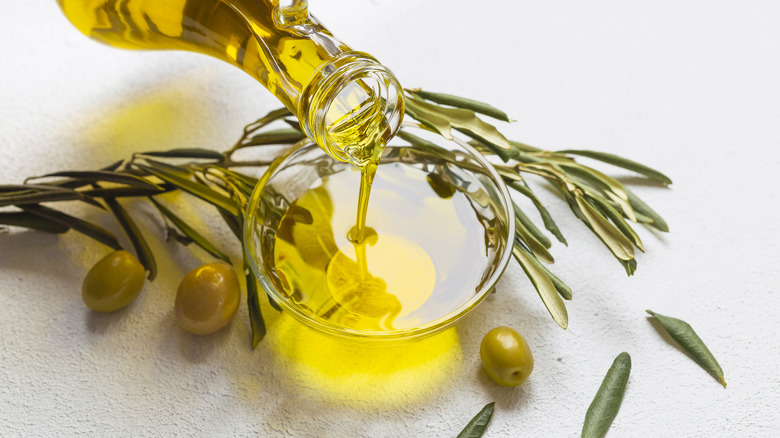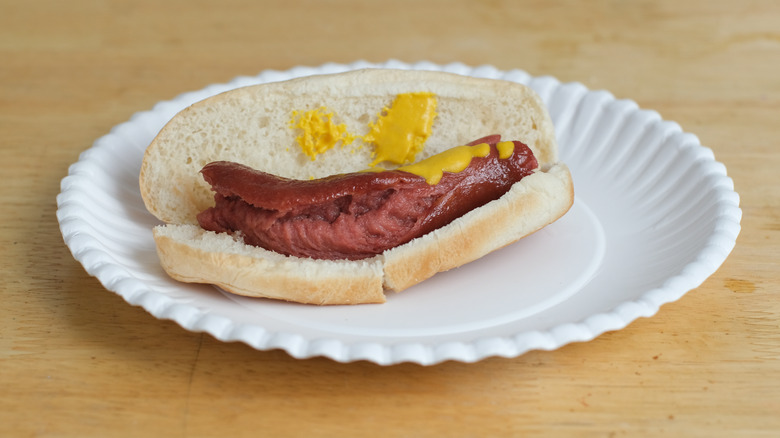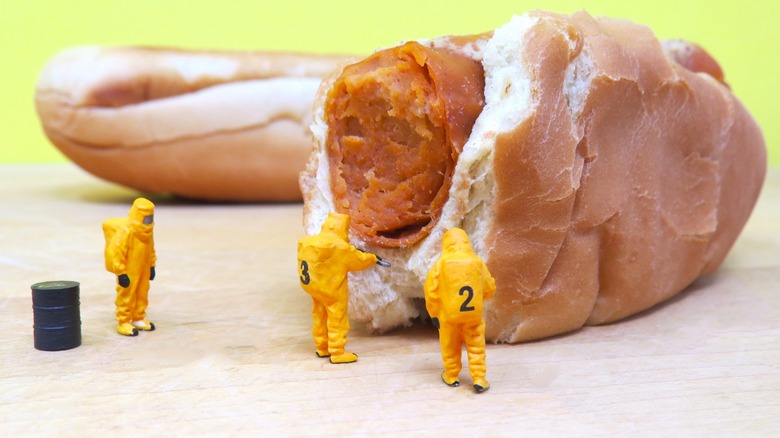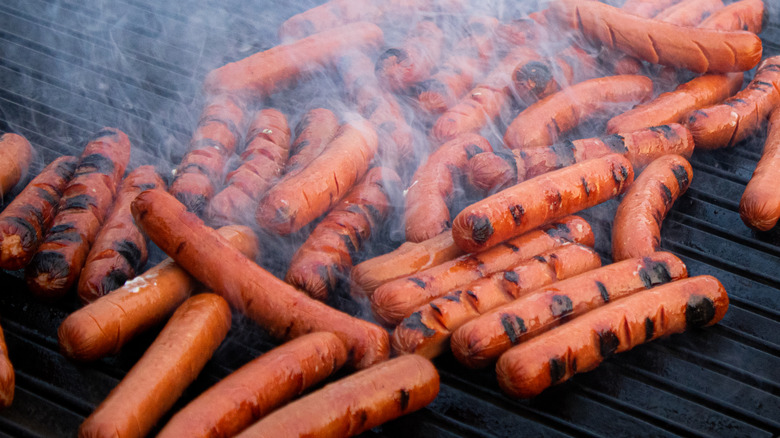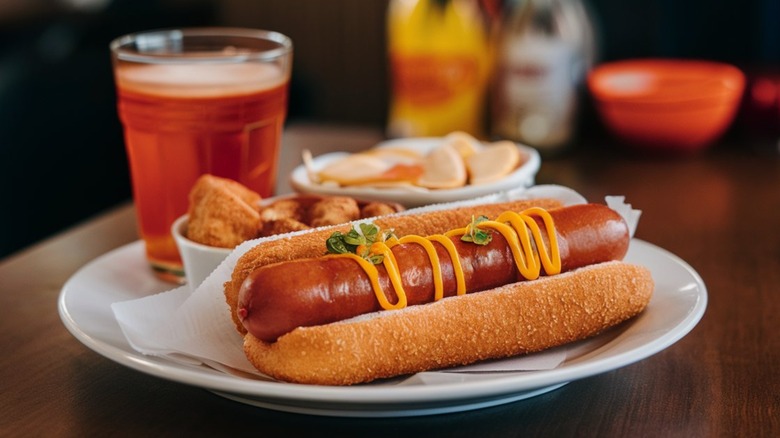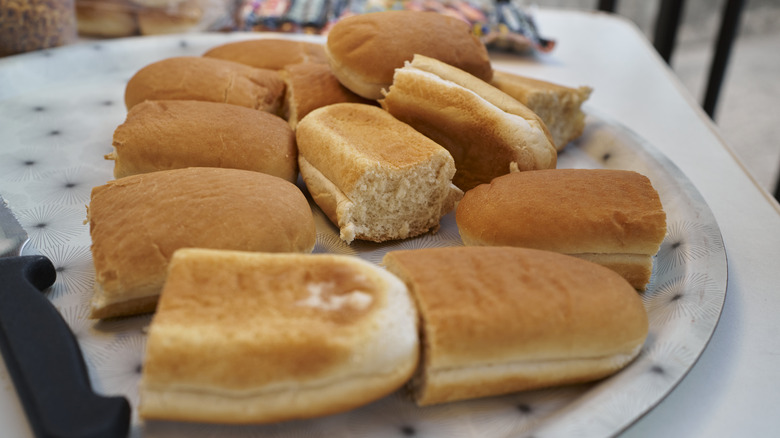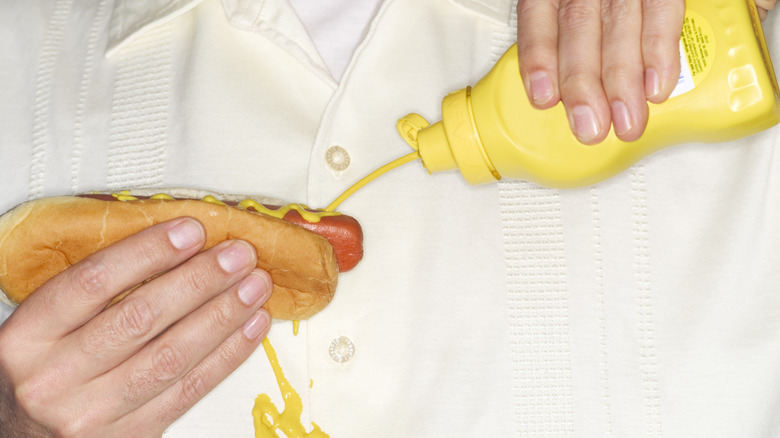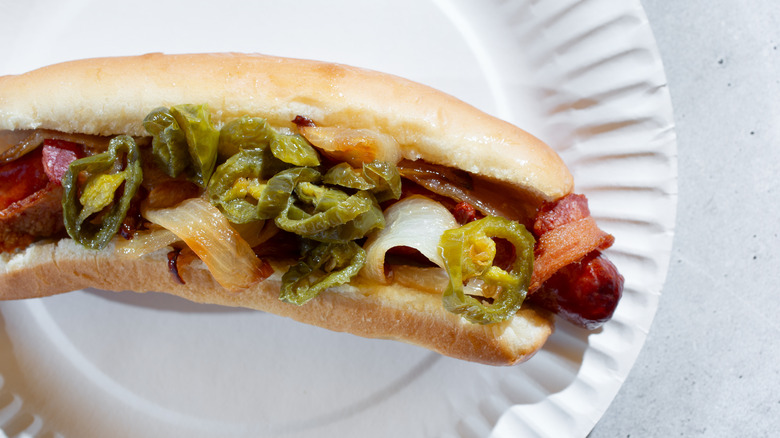12 Big Hot Dog Mistakes You Need To Stop Making
It's a beautiful day, the grill is smokin', and sure, somewhere, someone's dreaming of a tomahawk steak. But not you. You're craving a banger with a savory succulence that only an all-beef weenie can satisfy. So if you love hot dogs, it's high time to finesse those frankfurter fails.
The National Hot Dog and Sausage Council (which is real, by the way) ties the first-ever Frankfurter to Frankfurt, Germany, in 1487. Around the 1860s, dachshund sausages (not the dog) started to appear in the streets of New York City, served with bread. After making a splash in Chicago, the frank then got its official nickname in 1901 when a cartoonist who couldn't spell "dachshund" drew an image of a dachshund puppy-dog in a bun with the words "hot dog." True story or tall tale, hot dogs became an obsession for Americans, who now chow down 20 billion a year.
The humble wiener may not ask for much, but you've gotta bring your A-game if you want that perfect bite. From snagging the best brand on the shelves to grilling at proper temps, elevating the bun, pairing the toppings, and capturing that signature street vendor flair, we're here to prove exactly why you can always teach a (hot) dog new tricks.
You're shopping for bad dogs
We've got 99 problems, and all of them are hot dogs. Have you ever found yourself standing in front of the hot dog display case at the grocery store, wondering whether there were any real differences between the packages? Well, while most hot dogs are good, only some dogs are the G.O.A.T. It's all about setting the stage for that perfect first bite — one that snaps with a Goldilocks-style texture that's not too firm but also not too soft. While heat eventually plays a part in how your dog turns out, you may freely rig the odds in your favor with a high-quality, all-beef brand.
You can find top-shelf options at your local butcher, where the sourcing of the meat will be on point, and — bonus points — you'll support a local shop. That said, butcher-made dogs likely cost more than store-bought ones. Still, if you're cooking for a crowd, you can find great hot dogs at the supermarket. And Nathan's Famous Hot Dogs, Bar S Classic Franks, and Kayem Beef Hot Dogs are considered among the healthiest options.
You didn't preheat your grill
We totally get it if unrelenting hunger overtakes your brain, and you end up desperately tossing hot dogs on a lukewarm grate. But with just a little forethought and a properly preheated grill, those franks will come out looking and tasting their best. Preheating takes just a few minutes.
The reason for cooking on a piping hot grill is multifaceted. First, you're never gonna get those signature grill marks without a seriously toasty grate. As Barbecue University grill professor and author of "Barbecue Sauces, Rubs and Marinades" Steven Raichlen told People, "Start with a hot grill grate — hold your hand over it and if you can't get to three Mississippi before you say ouch, that's a hot fire." A cooler surface simply won't do the job of caramelizing the sugars in the hot dogs, adding that unbeatable char and smoky flavor. Not only that, a grate that's still heating up while your food is sitting on it may cause your hot dogs to get stuck to the grill. Nothing ruins hot dog time like a frank that's now melded to the rack.
But maybe the worst problem arises when the meat has to cook longer than it would have on a grill that has been preheated. This extra time on the heat could cause your favorite frank to dry and overcook as it reaches the proper temperature. Want to leave these issues behind? Crank up your grill for 15 minutes before grilling hot dogs.
You boiled your hot dogs
No offense to boiling — we're so down to boil corn on the cob, a pot of Yukon Golds, and even dulce de leche. However, when it comes to cooking hot dogs, most of us are probably envisioning the snappy texture of a perfect weenie from the grill. (Famously-boiled Chicago-style dogs, we'll get to you later.)
While you technically only have to warm them up, hot dogs can always benefit from a little extra flavor as part of the cooking process. Grilling instead of boiling adds flavor through caramelization and smoke. Add some smoky herbs into the mix by grilling your hot dogs on top of a bed of fresh, fragrant rosemary or thyme positioned directly on the grate, like French Chef and Restaurateur Daniel Boulud.
But if you just spent the weekend grilling up burgers and prefer to keep it chill in the kitchen, you can try boiling your hot dogs in something better than water: Beer. This method imparts tons of juicy flavor that complements a beef frank with hardly any effort on your part. While any beer goes down easy alongside a hot dog, fill your stock pot with something on the lighter end, like a lager, to keep the bitterness of heavier stouts and hoppy IPAs at bay.
You didn't chill
In the midst of a fun-filled BBQ or lively potluck picnic, it's easy to forget about a package of franks hanging out by the grill, waiting its turn in the summer sun. But while hot dogs can be left out at room temperature for up to two hours, according to the USDA, it's a shorter one-hour max window if warm weather tops 90 degrees Fahrenheit.
To err on the safer side of the hot dog and chill equation, keep your franks in the fridge or cooler until you're ready to pop them on the grill. Of course, while chilling is crucial for storing, you don't want to put them in the fridge and then forget about them for a few months, either. The Partnership for Food Safety Education notes that hot dogs can potentially develop harmful bacteria, causing a potentially dangerous listeriosis infection in humans. Keep it copacetic by storing hot dogs in the fridge for up to two weeks (unopened) or one week after opening, and a maximum of two months in the freezer.
Once the grill is sizzling, it's important to cook your hot dogs to the proper internal temperature to capture all of that beefy goodness with none of the risk of illness. Even though these emulsified sausages have already been cooked by the manufacturer during processing, it's recommended that you heat hot dogs to a minimum of 140 degrees Fahrenheit on the inside when tested with a digital thermometer.
You didn't oil up your dogs
Hot dogs kind of have a reputation for being loaded with fat and sodium. (Um, it's pronounced "flavor.") But even though the average frank dishes up roughly 6 grams of fat on its own, a little extra lube goes a long way toward creating the perfect exterior char. There's no need to marinate your dogs — you can simply brush a little oil on your franks before they hit the grill. Chef Daniel Boulud covers his hot dogs with oil to achieve a flash pan sear before placing them on the grill to finish cooking. But a good oil doesn't just work its magic on the stovetop.
Since grill temperatures typically hit somewhere around 400 to 500 degrees Fahrenheit, you can keep your meat from sticking to the hot grate (and any residue that might be on it) by coating your hot dogs with a little oil. Which kind of oil works best? Avocado oil has a smoke point of roughly 520 degrees Fahrenheit, which means it won't begin to disintegrate after a little exposure to the heat. On the other end of the spectrum, extra virgin olive oil has a much lower smoke point of 410 degrees Fahrenheit, yet it still falls within the standard range for grill oil, which requires a smoke point of 350 degrees Fahrenheit to 450 degrees Fahrenheit. If you love your EVOO, grill on.
You busted the hot dog casing by cooking too hot
We've all witnessed the tragedy that is a hot dog with insides that have busted through its outsides. Well, you no longer have to live with these types of franks (and you don't have to get creative on scoring them, either). It all comes down to the proper heat-to-hot dog scenario. A broken casing is just a sign that you came in way too hot with the heat. To achieve the ultimate smoky char on your frank while maintaining a moist and tender middle, grill your hot dogs over an indirect source of heat. A few little pokes in the casing will also allow steam to release gently without potentially bursting through the walls.
Another strategy to cook without carnage involves simmering the hot dogs in a liquid bath on the grill. In an aluminum pan, place your weenies in a brothy marinade (this could be beer or tomato sauce or sauerkraut, onions, and mustard), and simmer on the hot half of your grill, then move to the cool side to continue cooking. Once you're ready to eat, move the warm hot dogs to the hot grill grate to finish by crisping up the casing. This method eliminates exploding heat-shocked hot dogs by introducing them to the heat like they're sliding into a hot tub.
You forgot about the fat content
Maybe you're feeling all the flavor and vibes of hot dogs, but you're not into the fat. If you pick up a pack of reduced fat or even 97% fat-free franks — which can have as little as 1 gram of fat per serving (some plant-based dogs have 0 grams of fat) — just remember that leaner meat often needs a gentler form of heat. Regular hot dogs range from 10 grams of fat per link to 18 grams of fat per link. With that math, a two-dog lunch could already put you over 50% of the daily recommended fat for adults. Considering that a percentage of that fat will probably be saturated fat, which could raise your "bad" LDL cholesterol, it's no wonder some people might choose a lighter link.
But since there's not as much fat to keep the hot dog insides tender and juicy, you may need to adjust your cooking method. To prevent the devastation of an overcooked (and dried-out, shriveled-up) weenie, don't forget about your slow cooker as an option for gently heating your dogs while keeping them moist and flavorful. While it's also recommended for other leaner beef cuts, slow cooking preserves the juices already present in hot dogs — no additional water is needed. Plus, it allows you to cook enough for a small village and keep them nice and toasty on the convenient warm setting. A hot dog bar is a go, people.
You put too many hot dogs on the grill
Once the grill is fired up, it's tempting to put the pedal to the metal and load up the grate with enough hot dogs for all your hungry guests. But if you're cooking for a big crowd, it's even more important to leave some extra room on the rack to flip and turn your franks. Grill pro Steven Raichlen recommends keeping roughly ¼ of your grill space completely free of any food.
Using this strategy, if one dog happens to catch some extra heat, they don't all go down in flames together. He explained to People, "On a gas grill, you can leave one burner off, and on a charcoal grill you can keep the charcoal to one side." Not only could you legitimately save dozens of innocent hot dogs from being relegated to the trash, but this tactical grilling blueprint also allows for a space to grill your franks away from the flame or coals, using indirect heat. (You know, for those low-fat turkey links your cousin brought to the picnic.)
You got stuck in a dog-cooking rut
Hot dogs aren't supposed to be complicated. But once you've mastered your go-to cooking method, you might find yourself scrolling on your phone late at night, wondering if there's something better out there. The good news is that you don't have to ditch your favorite hot dog to spice up your technique.
The world of Frankfurter creativity is already yours. Craving that crispy outside minus messing with a grill? Pan-fry your hot dogs with a little water (and then finish them off with oil or butter). Want all the glory of a grilled hot dog but don't have the equipment? Serve up an oven-roasted frank that turns out just as juicy and snappy as it does on the grill. You can even nuke your dog for the fastest results — just make sure to wrap it in a paper towel so it stays tender and juicy.
Of course, let's not overlook what may be the most sacred of meat preparations: The hot dog deep-fry. Set yourself up for textural bliss by sourcing hot dogs that have natural casings which, when fried, create an ultra-crispy outside. Then, canola or vegetable oil provides the perfect neutrally flavored frying scenario. Going for a slight crisp? It only takes a minute in the fryer. Two to four minutes get you a bold, slightly ripped, and super tasty frank.
You neglected your buns
With all the attention going to the beef, don't let your hot dog buns get lost in the shuffle. Maybe you've spent nary a second thinking about buns — except for why they're almost never sold in complementary numbers to hot dogs — but that doesn't mean it's too late to elevate your modus operandi.
Contrasting the feel of a sturdy ciabatta roll or crusty baguette, hot dog buns work best when they're pillowy soft with a marshmallowy chew and just enough structure to handle a frank and all your favorite toppings. (Potato rolls, you're in a class all your own.) Just about any bun can benefit from the bread version of caramelization known as the Maillard effect, which highlights the reaction between sugar and amino acids that gives us that irresistible flavor we know best as "toast." But don't stop there. Smother your buns in a light schmear of melted butter, oil, or mayo, then, after a quick spin on a hot grill for a little browning (a toaster oven or frying pan works, too), you're ready to load 'em up.
You biffed it on flavorful toppings
While you can always season your hot dogs before they hit the grill, the delectable fat in most beef hot dogs practically screams to be topped with something noticeably acidic or tangy to make the flavors pop. Luckily for Frankfurter fans, the world is your toppings oyster.
Hot dog loyalists dazzle their dogs with all sorts of things, from chili to slaw and deliciously greasy peppers and onions. But while there is a time for ceremoniously drowning our dogs in the kind of bright orange nacho cheese you can get from a pump, if you really want to celebrate the spirit of a hot dog, make sure to include something that clearly hails from the acids group.
It may be a Chicago thing to never put ketchup on a hot dog, but tomato and vinegar-based ketchup is an obvious first choice. Still, it's definitely not the only option. Lean into tried and true classics like relish, sauerkraut, pickled onions, and myriad mustards. (Yellow mustard if you're keeping it classic.) Chopped white onions, sliced pepperoncini, and coleslaw all add crunch and tang that will take your Frankfurter to the next level, but spicy jalapeño relish does all that while possibly making you forget your own name.
You didn't street-dog it
As a beefy love letter to the regional hot dog styles of our nation, we honor the cult-favorite icon you'll find in almost every major city: The street vendor dog. This Frankfurter beckons you with an aroma that lifts you off your feet like a cartoon character floating toward a pie in a window. But you can nail these metropolitan flavors at home, too.
First up, with roots going back to the 1860s, there's the New York City-style hot dog. Of the thousands of push-carts peppering the Big Apple, many serve Sabrett beef franks. To do this pleasantly-smoky dog justice, boil it and top it with Sabrett brand mustard, tangy sauerkraut, and onions in tomato sauce. Hopping over to the Midwest, some call the Chicago dog the best in the world. Going for big, bold flavor, this frank features an all-beef hot dog on a poppy-seed bun, religiously topped with chopped white onion, bright green pickle relish, a slice or wedge of fresh tomato, a pickle spear, pickled sport peppers, and a dash of celery salt — no exceptions.
Over on the West Coast — famous for what's lovingly known as "Danger Dogs," "Tijuana Dogs," or "Dirty Dogs" — Los Angeles does its signature hot dog with crispy, bacon-wrapped, griddled all-beef franks topped with caramelized onions, peppers, and chiles on a plain white bun that's not toasted but is still warm from the cooktop. Long live hot dogs, whatever way you like them best.

